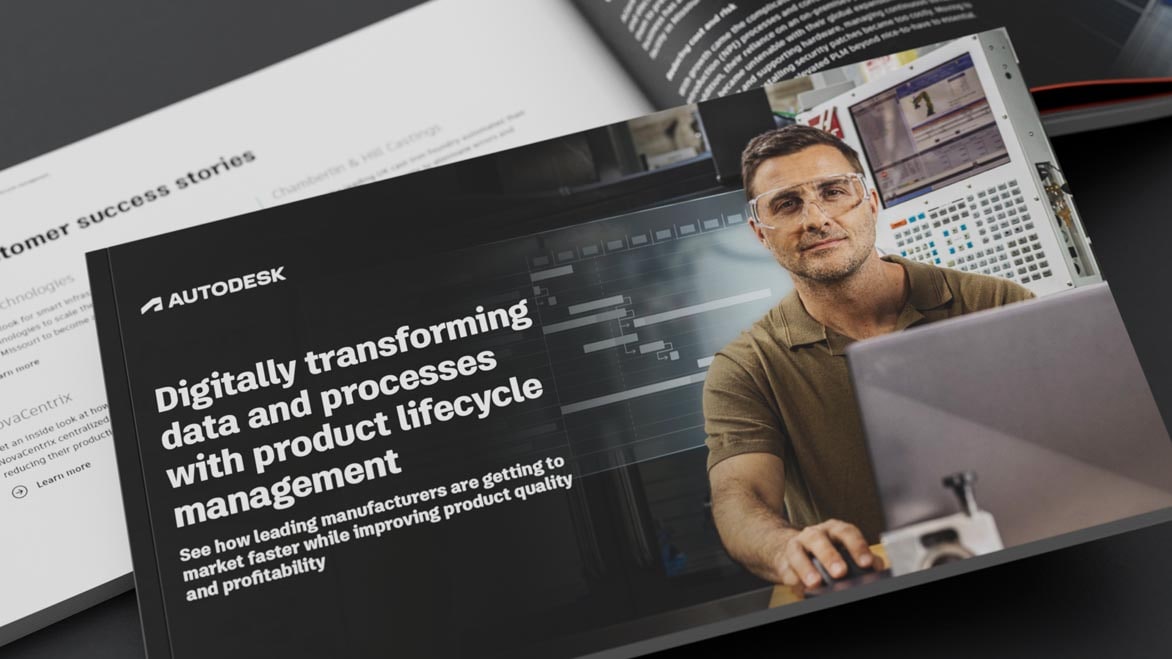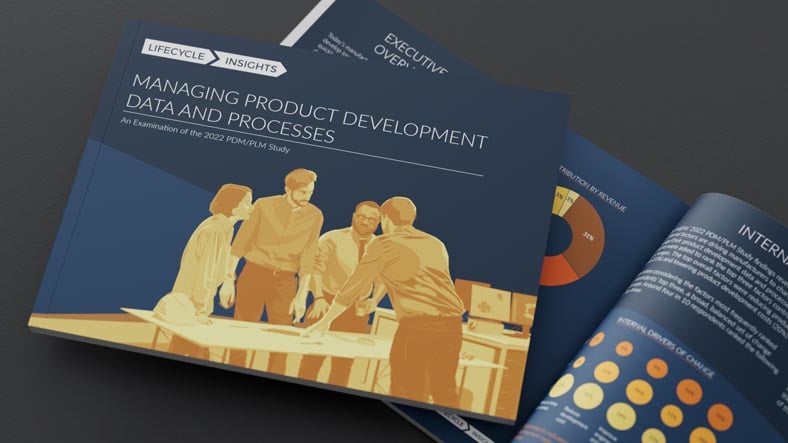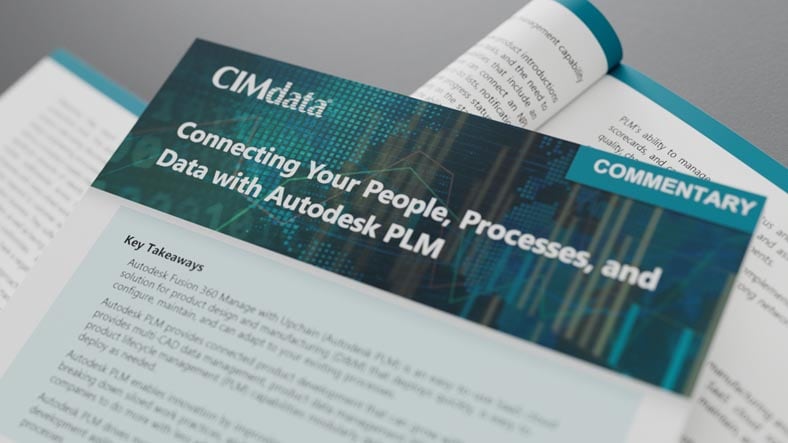& Construction

Integrated BIM tools, including Revit, AutoCAD, and Civil 3D
& Manufacturing

Professional CAD/CAM tools built on Inventor and AutoCAD
Every day, manufacturers juggle multiple CAD systems as they move from concept to delivery, opening their process to confusion, data loss, and delays. Autodesk PLM provides multi-CAD integrations that keep teams working in the tools they know and collaborating efficiently across your organization and with suppliers–regardless of file type.
Read how industry leaders use PLM software to remove product development collaboration barriers, accelerate processes, increase efficiency, and power agility.
Speed-up development through centralized CAD-integrated PDM (US site) and workflow automation to spend more time on high-value tasks.
Vastly improve collaboration, make better decisions earlier in the process, and track costs and materials with real-time system-wide data sharing.
Improve supply chain collaboration and response time with easier order visibility and control and real-time markup and feedback loops.
Adapt in real time to a changing market, from concept to production, with greater innovation, fewer iteration cycles, and lower costs.
Centralize product-related data and processes. Reduce time spent on low-value tasks, increase product development agility, and streamline collaboration by bringing all your project data into one place.
Document, track, and review every component in your product, prepare for manufacturing, and maintain data integrity throughout the entire product lifecycle with effective BOM management.
Enforce control over revisions to designs, items, and records during the many phases of the product lifecycle. Help departments efficiently automate and document revisions for enterprise-wide visibility and traceability.
Configure project templates and standardize phase-gate milestones, deliverables, and tasks by product line, business unit, or product team. Go from concept to production with more speed.
Stay connected 24/7 to your global supply chain with anytime, anywhere access to the information your extended organization needs for quoting, procurement, and supplier management.
Automate quality workflows, track and record changes, and analyze quality metrics to prevent issues. Reduce defects and non-conformities. Improve product quality and reliability.
WEBINARS
Learn from Autodesk experts about product lifecycle management tips, tricks, and best practices. View our extensive library of product lifecycle management webinars to learn how you can streamline collaboration, increase agility, and improve product quality with Autodesk PLM.
Lifecycle Insights Report
Numerous factors are driving manufacturers to explore new approaches to managing and executing product development data and processes. Learn why the industry is ditching traditional methods and embracing PLM to get projects to completion faster.
CIMdata commentary
Modern companies require a strategic approach that enables them to start small and scale their PLM environment as required. Read advice from digital transformation experts CIMdata on why you need a connected product development solution that can grow with you.
Getting started with Autodesk PLM is within reach. Talk to Autodesk sales about how modular processes and configurable, out-of-the-box workflows offer the flexibility to implement what you need, when you need it.
PLM stands for product lifecycle management. Product lifecycle management provides enterprise-wide collaboration for all involved in the product lifecycle—from engineering and supply chain to quality and manufacturing. With everyone working from a central source, you can bring better products to market faster.
PLM software is a solution that manages data and processes throughout the product lifecycle, from initial idea through development, manufacturing, service, and retirement. PLM software centralizes and automates process workflows and enables cross-functional collaboration for all stakeholders. PLM software provides such capabilities as new product introduction (NPI), bill of materials (BOM) management, change management, supplier management, and quality management.
Using PLM software for data and process management gives manufacturers more agility and resilience in an ever-changing world with increasingly complex products, customer demands, global market conditions, and competition. PLM frees up time and resources across the enterprise to respond to business opportunities and solve challenges faster with greater innovation and adaptability.
PLM enables real-time collaboration across the organization as well as with external, third-party stakeholders such as suppliers, vendors, contractors, and customers. PLM brings all stakeholders and departments together, so product design, engineering, manufacturing, and quality data stay connected. By connecting people, processes, and data in a central system, PLM helps organizations improve collaboration, increase product development and supply chain agility, reduce time wasted on non value-add processes, improve product quality, and get to market faster.
Most companies operate in functional silos. Product information can become isolated in departments, disconnected network drives, and individual computers. Different processes involving people and information from multiple functions are inconsistent. Product information is hard to find and often outdated. This leads to errors, delays, and inefficiency. Product lifecycle management is important because it breaks down silos with centralized data and workflow automation effectively connecting people, processes, and product information across the enterprise.
Product lifecycle management dramatically improves how companies create, build, support and evolve products and services. PLM reduces errors and helps ensure that everyone can access and work with the most up to date and accurate information when and where they need it. PLM removes collaboration barriers and increases efficiency and agility.
PLM software also provides KPI dashboards, which reduces time wasted manually coordinating project tasks, reporting, and audits. Using PLM also helps improve product quality by making product performance data available to engineers for closed-loop traceability and design improvements earlier in the development cycle. These are just several examples why product lifecycle management is important. Companies of all sizes, across industries and geographies profit by using PLM.
Product lifecycle management is used by discrete manufacturers and supply chains involved in the development of such products and equipment as industrial machinery, consumer products (US site), building products and fabrication, automotive and transportation (US site), electronics, and medical devices.
Autodesk PLM gives you the flexibility to start today and expand tomorrow with data and process management that adapts to your business. CAD integrated data management (US site) keeps everyone working in the design tools they know with plugins for the most widely used systems. And process management standardizes workflows for design collaboration and review, bills of materials, change, quality, new product introduction, supplier collaboration, and more.
Autodesk PLM helps you standardize business workflows. It comes with core PLM apps and dozens of specialized processes at no extra cost. And rather than starting from scratch, they have out-of-the-box workflows that you can tailor to your business needs. Implement the functionality you need, when you need it. Autodesk PLM is a central source of truth, managing all your data and processes, and with its open API, it integrates easily with other business systems such as ERP and CRM so you can do even more with your data.
Product lifecycle management helps you manage the many moving parts of your product lifecycle, including capabilities for:
At Autodesk University (AU), customers share how they solve problems in their design and engineering businesses with the help of Autodesk PLM software.
Click here for a curated list of design and engineering resources from AU (US Site).
AU is an annual conference and online learning platform that brings design and engineering professionals together.
AU offers a range of learning opportunities, including high-level thought leadership presentations, case studies, and hands-on learning for tools such as Fusion Manage & Autodesk Vault. Click here for a curated list of AU classes on the topic of Product Lifecycle Management (US Site).
Attendees can network, learn, and discover new Autodesk software techniques and industry trends that can help them improve their business processes through the digital transformation of their workflows.
The foundation of PLM is PDM (US site), centralized data management of all file types and any information related to a product. PDM integrates with CAD systems and helps enforce organizational standards for data creation, review, and release processes, as well as industry standards. During the design and engineering phase of a product’s lifecycle, PDM tracks revisions, reduces errors, and improves design reuse and collaboration.
But what about other departments beyond engineering and other business processes that use product data? That’s where PLM comes in with processes that enable enterprise-wide access to data and collaboration for all involved in the product lifecycle—from engineering and supply chain to quality and manufacturing. Autodesk PLM combines PDM and PLM capabilities for product data and process management efficiencies throughout the product lifecycle.
Manufacturers need to be more innovative and resilient than ever. There’s constant pressure to change due to internal and external forces such as customer expectations, market conditions, supply chain issues, and competition.
To address their challenges, manufacturers are digitally transforming how they operate. They’re evolving outdated product development methods by using technology solutions that reduce waste and increase time and resources for innovation. PLM is key technology solution and enabler of digital transformation with data and process management capabilities that are more efficient and effective than manual efforts and disconnected systems.
PLM connects people, processes, and data across the enterprise to create a collaborative environment for all involved in the lifecycle of their products, including suppliers, partners, and customers. This allows manufacturers to spend more time on innovative ways of working, while reducing development costs and cycle time, so they can focus resources on getting more competitive products to market faster and seize more business opportunities for growth.
PLM gives everyone access to the right data at the right time in a centralized system that helps reduce errors and improve productivity throughout your organization. Teams can collaborate with each other across departments, divisions, and geographies. Your organization can control what data people can access and edit based on their roles and projects. Revision control ensures everyone is referencing the correct version and reduces the risk of downstream errors and re-work. Change management with traceability of change requests and change orders is displayed in real-time.
PLM keeps up to date supplier information centrally accessible for any stakeholder any time it is needed, including approved vendors, what they supply, pricing, contact information, historical audit trails, and more. This helps prevent using the wrong suppliers who may have had previous quality issues or are not in compliance with industry standards and regulations. The PLM system automates supplier review notifications and tracks their approval status in real time.
Collaborating with suppliers is easier with PLM. Rather than exchanging emails back and forth or using shared drives where data can become outdated or lost, using a PLM system centralizes data and processes. Suppliers can access drawings and 3D visualization models and participate in the RFQ process seamlessly. And you can share real-time markup and feedback loops during design collaboration for more effective and efficient communication. PLM helps shorten supplier lead times and improves the accuracy and quality of their deliverables to your requirements.



